Fishing Report: November 26, 2021
MADEIRA BEACH, Fla. - Every Friday morning, Captain Dylan Hubbard of Hubbard's Marina joins Good Day to fill viewers in on his fishing forecast as we head into the weekend.
Here is his fishing report for November 26, 2021.
Inshore
Snook are feeding well around the area again this past week. We are seeing a more moderate tidal flow through the weekend and the start of next week. So, fishing may be a bit tougher until later in the workweek when the new moon gets the water moving once again.
These snook are very focused on the presence of the bait. They are moving and staying in areas where their prey is most prevalent. We don’t have any big systems moving through the area this coming week so the fish shouldn’t be moving areas too much.
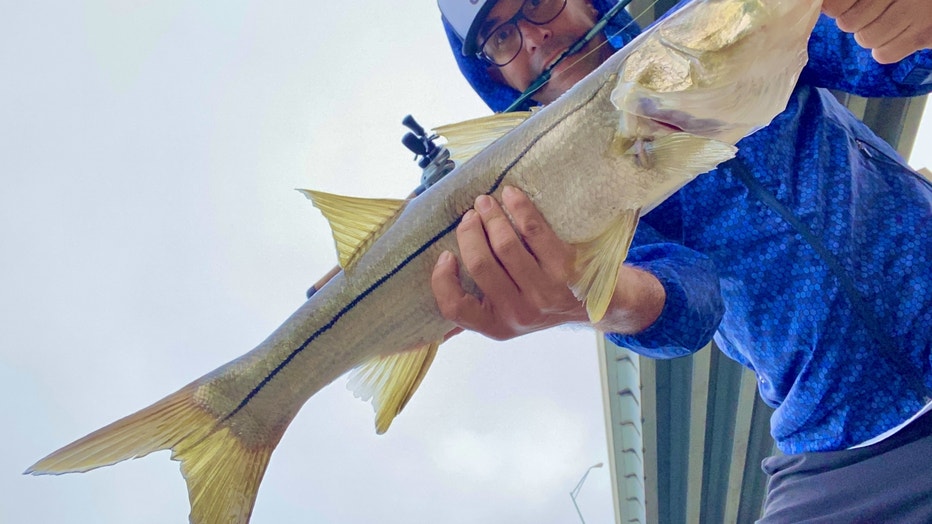
Snook (Credit: Hubbard's Marina)
Plus, with calmer conditions, the water will clear up considerably making the snook a bit more leader shy as well with clearer water. We do have some higher-than-normal tides coming this week allowing the fish to get up on the mangrove shorelines more than normal and push into areas that are typically too shallow to feed.
On those high tides, look for the snook in those areas that are 1 to 2 feet deep that would be normally exposed at lower to mid-tides. The passes are still holding some fish, but the majority of action is moving to the back bays.
Soft plastics, swimbaits, and jerk baits are all working well for artificials. Pinfish, pigfish, whitebait and shrimp are all good live bait options for the snook too. Dock lights at night remain a great area to find hungry snook when water is moving and bait is present.
Redfish action has been steady lately -- nothing crazy -- but when you can find the fish they are ready to eat in most cases. Look for the redfish around those oyster bars, mangroves, and grass flats. We are also finding them around the docks, piers, and bridges where the sandy bottom allows them to cruise and transverse areas looking for crustaceans and greenbacks.
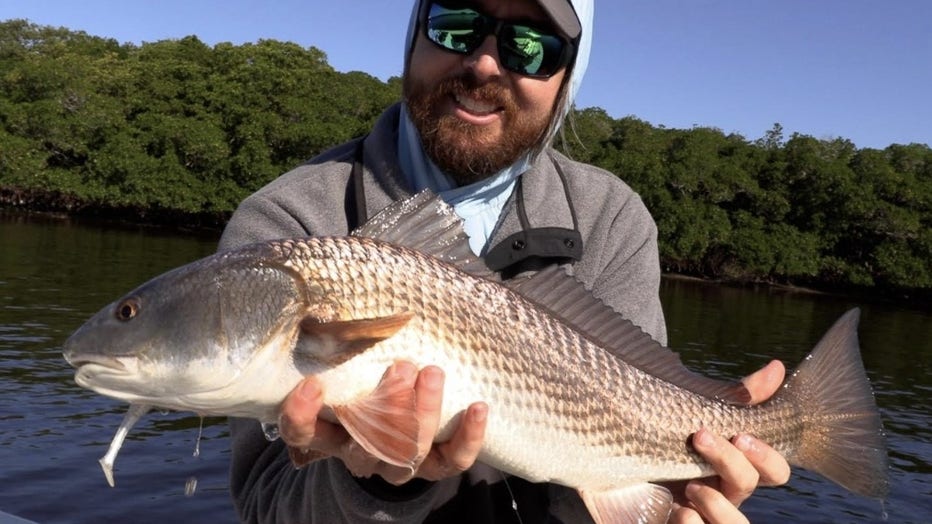
Redfish (Credit: Hubbard's Marina)
Soft plastics remain the best option all around for the redfish, but bucktails work well, gold spoons, and in low light conditions like early morning the surface lures provide exciting strikes.
Trout action is a bit tougher than historic levels, but you are able to find areas holding active trout. Look for them around those cuts, potholes, and edges of the flats. Also, dock lines, bridges, and piers could be holding them too where the bait is present.
We are seeing them often around those dock lights and bridge lights at night when bait concentrates at these areas too. Soft plastics, shrimp or whitebait are great options for targeting the trout around the area.
Mangrove snapper are still mixed in with the sheepshead around local structures and rock piles. However, they are becoming smaller overall sized as many of the bigger mangroves make their way out of the back bays and into the near shore waters.
Sheepshead are getting to be more and more prolific around local structures like docks, piers, bridges, jetties, seawalls, and rock piles. Look for them using fiddler crabs, live shrimp, cut clams or oysters. While doing so, use that lighter tackle like 15-20lb test and 1ot hook and minimal weight.
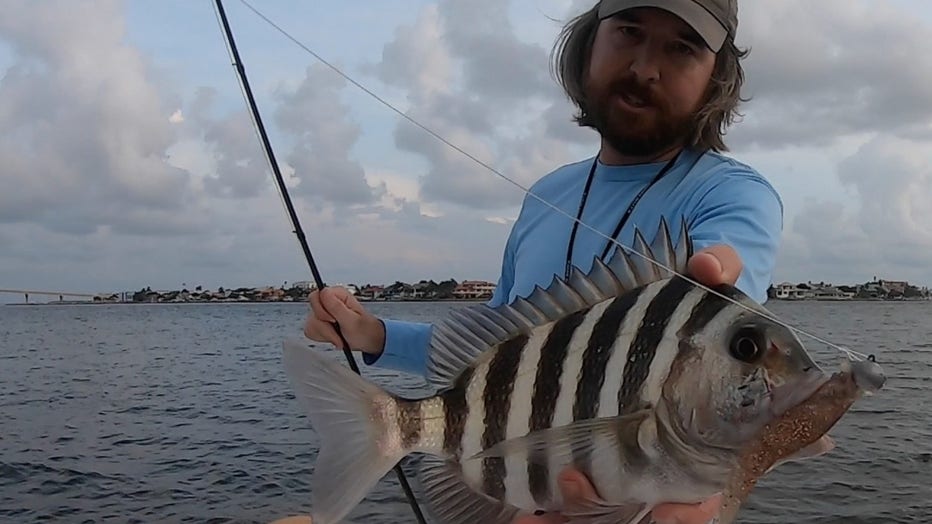
Sheepshead caught inshore (Credit: Hubbard's Marina)
You can also find them cruising the oyster bars around the flats and sometimes those mangrove shorelines will hold good numbers too.
Flounder action is good around the area, but they are still in a spawning closure until December 1st. However, once they open, you will find them around those sandy areas near the passes as they make their way back inshore from those near shore spawning sites adjacent to the big structures near shore.
Passes like Pass-A-Grille, Blind’s Pass, Bunce’s Pass, John’s Pass, and others are great areas to find them around the structures hanging on that sandy bottom. Also, drifting the sandbars, working the bottom with soft plastics, pompano jigs, or drifting live shrimp, is a great technique to target them too.
Pompano have been steady around the area lately too and should really pick up more and more through early spring. They spawn in the summertime and that makes them harder to find, but behind the first few big fronts, they concentrate along the beaches, passes, and sandbars to hunt for crustaceans like crabs, sandfleas, and shrimp.
Once the water gets cooler, those warm water outflows are great areas to target them like the power plants and areas where shallow back bay area’s discharge.
Triple tail are still super prevalent around the area’s floating debris, markers, and buoys. Throughout stone crab season, we see these guys on the crab trap buoys, but they are especially thick right now. The tricky part at this time is finding some larger ones to keep as they now have to be 18 inches to take home, which is a larger tripletail.
Near shore
Hogfish action is really heating up around the area now and we’re hoping to see the trend continue. This past Monday, we went out on a 10-hour and caught around 26 keeper hogfish hunting from spot to spot in around 40 to 60 feet of water.
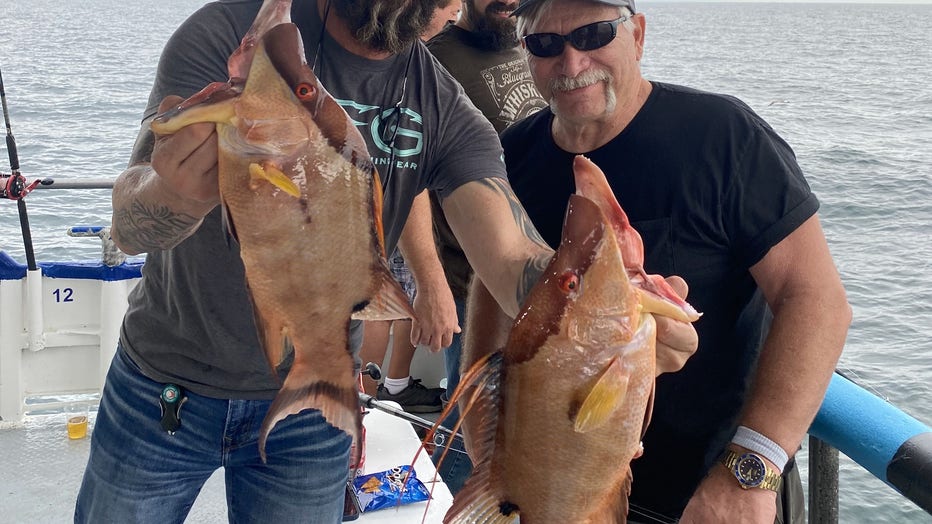
Hogfish (Credit: Hubbard's Marina)
We are seeing the same conditions around the area of a few hogs here, and a few there while bouncing between those small ledges, hard bottom areas, and rock piles near shore. Lighter tackle, live shrimp, and a lot of patience will help you get after the hogfish. We saw the Nekid ball jigs, jig heads, and the knocker rigs all work well this past week as far as techniques but you can catch them on the typical fish finder rig too.
Live shrimp is key when targeting the hogfish near shore, but you need a ton of them as many other species love to eat the live shrimp too!
Gag grouper action is really picking up near shore at this time too. We are seeing them really start to fill in the near shore waters between the hot offshore areas that have been producing well and the steady inshore gags of Tampa Bay.
Now we’re seeing more and more of these guys around 40 to 100 feet of water near shore around the ledges, rock piles and bigger structures hunting the frisky live baits, butterflied dead baits and sometimes even large live shrimp will get a gag grouper’s attention.
Mangrove snapper action is steady near shore -- not crazy -- but you can find some nice ones while hunting the hogfish or gag grouper near shore. Look for them on the live shrimp using a jig head or knocker rig or a small chunk of threadfin on the double snell rig.
Lane snapper is still are closed but should hopefully be re-opening soon. Luckily, we know they must reopen after January 1st. These guys are thick near shore and seemingly get bigger and bigger all the time. We find them using shrimp, small threadfin chunks, or even cut squid.
Kingfish action near shore is still possible, but it definitely wasn’t like what we are used to. We never saw huge concentrations of kings near shore this year due to the red tide issues on our coastlines coinciding with when we historically see the kingfish show up.
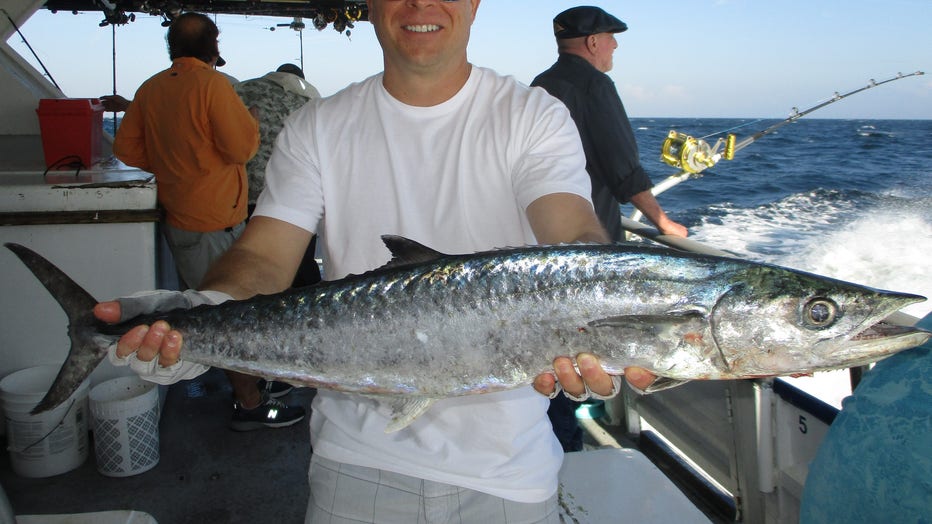
Kingfish (Credit: Hubbard's Marina)
There’s still some around and some mackerel too, but the bait schools we typically see just didn’t exist or got killed off in the red tide blooms so we haven’t seen big areas of the kings this fall.
Offshore
Gag grouper is the king of the offshore report right now. Last weekend’s full moon trip absolutely destroyed the gag grouper despite terrible weather conditions.
Even with 5 to 7-foot seas, with the occasional 9-foot rouge wave, they brought home nearly 90 keeper gag grouper for the few anglers fishing.
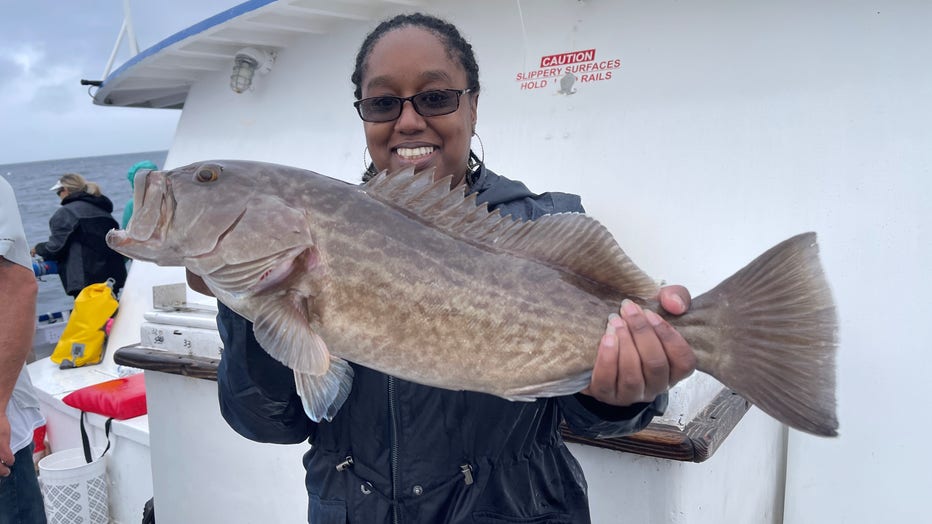
Gag grouper (Credit: Hubbard's Marina)
Many anglers in our area are seeing the same thing on longer runs beyond 30-50 miles offshore. Big live baits, big tackle and timing your trips around the weather is key. Right before a front and right behind a front in deep water is best. Looks like this weekend and start of this week should bring similar conditions with weak fronts moving through the area.
We’re hoping for another killer trip on our weekend 39-hour and the long range 12- hour extreme trips and the private fishing charters here at Hubbard’s Marina.
Luckily, pinfish is getting easier to get in our area, which really helps to target the gag grouper out deep. However, if you run out of the live bait from shore, the big live baits you get out there like the porgies, white grunts, and others make for great bait and you can even butterfly them to target the gag grouper in deep offshore waters too.
Scamp grouper are biting well if you make it out there closer to 160 feet of water or more. We are seeing them most often while targeting mangrove snapper with smaller pinfish or cut threadfin. They are often around the areas we target mangroves and gag grouper in the deeper offshore waters.
Mangrove snapper action is going really well for us offshore too, beyond 100 to 120 feet of water, we are seeing some large mangroves in good numbers. This past long-range trip brought one mangrove nearly 10lbs back to the dock. Double snell rigs really help to target the mangroves with 40-60lb test and around 6ot hooks.
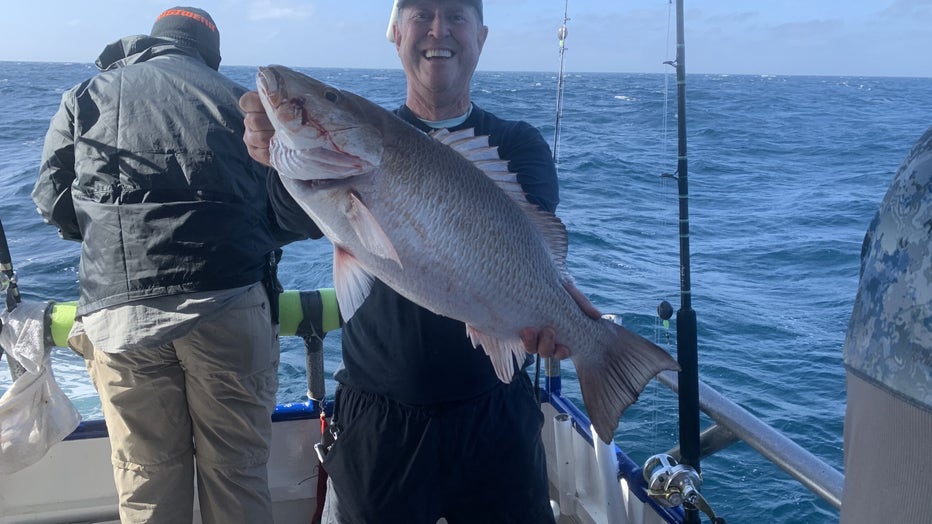
Mangrove snapper (Credit: Hubbard's Marina)
Blackfin tuna are thick offshore right now with many moving past our area as they spawn this time of year up to our north. We will find them well around the next few weeks trolling lipped plugs, cedar plugs, dredges and skirts. Also, flat line fishing is a great way to get a few blackfin while bottom fishing. We are seeing them come up while people are reeling in live and dead baits from the bottom too.
Don't be a fool; bring a venting tool and/or a descending device
It is so important to keep in mind the importance of dead discards and discard mortality when engaged in near shore or offshore fishing. If we can all work together to change the cultural norms near shore and offshore, we can all help to improve our fishery and our fishery access overtime.
How many do you know right now that are all for catching and releasing snook, redfish and trout but will be the first in line to kill a mangrove snapper, gag grouper or red snapper and the attitude completely changes when discussing these offshore species?
Plus, the same person inshore that will hold their breath and wet their hands before handling a breeder snook will go offshore and then cull through 20 red snappers before keeper their two red snapper they deem large enough to fill their two fish bag limits while the other 18 they released will often end up suffering fatal damage if not properly descended or vented?
Please help us to spread the word on the importance of descending or venting your released fish. Descending devices are most easy to use and quick to pick up on their use and are most effective for most anglers. However, an expert and precise angler with proper training and tons of experience can use a venting tool properly with similar outcomes. However, a venting tool requires you to pierce the fish while most descending devices are much less invasive.
While using a venting tool it is imperative you pierce them in the exact right spot, and you do not go but a quarter inch or less in the fish. Most venting tools require you to ‘choke up’ on the tool to prevent over penetration into major organs.
When fishing deep water, especially in the sweltering summer months, please make sure to treat all fish intended to be released like that breeder snook inshore and minimize the time it takes you to get him from the bottom to the boat using heavier proper tackle not an ultra-light spinning reel. Then once on board, minimize the time out of the water. Then use a proper dehooking tool, and then for the love of God, use a descending device or venting tool PROPERLY to ensure that fish has a chance to live another day.
Three things will help ensure the survivability of those fish released offshore.
- Making sure they are brought up quickly and do not expend all their energy in the fight.
- Make sure they are unhooked smoothly, easily, and as quickly as possible.
- Finally, make sure they spend the least amount of time at the surface at negative pressures where barotrauma exponentially increases its effect with each passing second.
Also, keep in mind when the water is warm there is less dissolved oxygen content and the chances of barotrauma increase even more while its effects can be even more deadly.
CHECK OUT THE NEW WEBSITE and marketing campaign to get your own FREE descending device and more information on mitigating barotrauma and barotrauma issues! Do not forget to use the hashtag #ReturnEmRight to help spread the word too on fish you catch and release offshore -> https://returnemright.org/
Here’s MORE information on barotrauma and how to mitigate that fatal damage to your future offshore catch -> https://gulfcouncil.org/eastern-gulf-barotrauma/
State survey to improve recreational data and access
It is imperative that you have your gulf reef fish survey endorsement on your fishing license if you are a private recreational angler or diver fishing from a private boat anywhere in Florida who intends to harvest, attempt to harvest or possess one or more of the following reef fish species: mutton snapper, yellowtail snapper, hogfish, red snapper, vermilion snapper, gag grouper, red grouper, black grouper, greater amberjack, lesser amberjack, banded rudderfish, almaco jack, gray triggerfish, Gag grouper, Red grouper, Scamp grouper, Mangrove snapper, Lane snapper, Kingfish, Tuna, or Mahi mahi.
Here is all the information and more on that program and how you can sign up -> https://myfwc.com/fishing/saltwater/recreational/state-reef-fish-survey/
TERMS OF REFERENCE:
INSHORE – from the back bays out to the bridges and including right on the beaches
NEAR SHORE – From the beaches out to 20 miles, or up to 100ft of water
OFFSHORE – from 20 miles or 100ft and beyond
For more fishing reports, photos, videos and more check out Hubbard’s Marina on Facebook, Instagram, YouTube, or Snapchat. Just simply search "HubbardsMarina" and do not forget our family motto, "If you’re too busy to go fishing, you’re just too busy!

